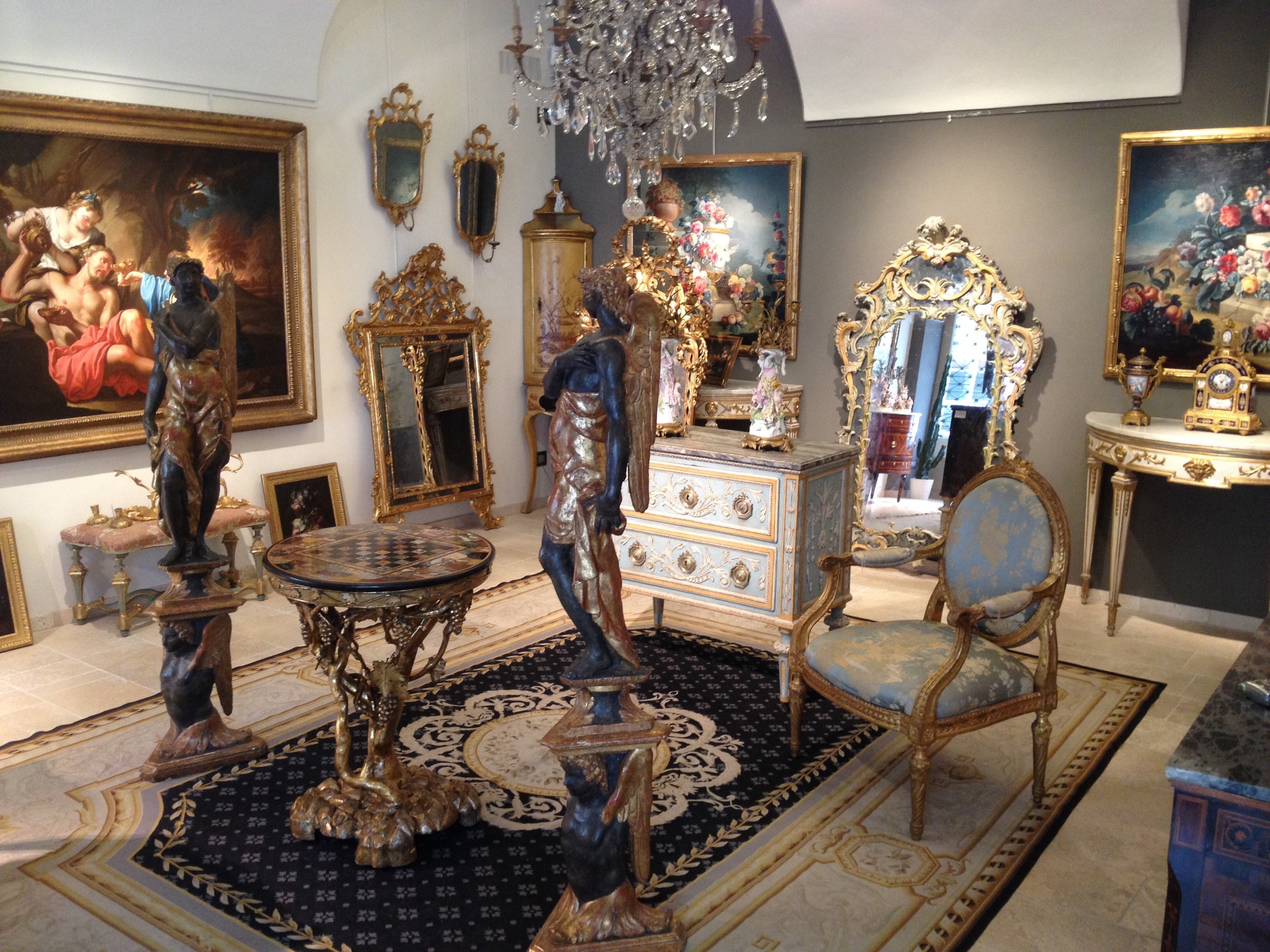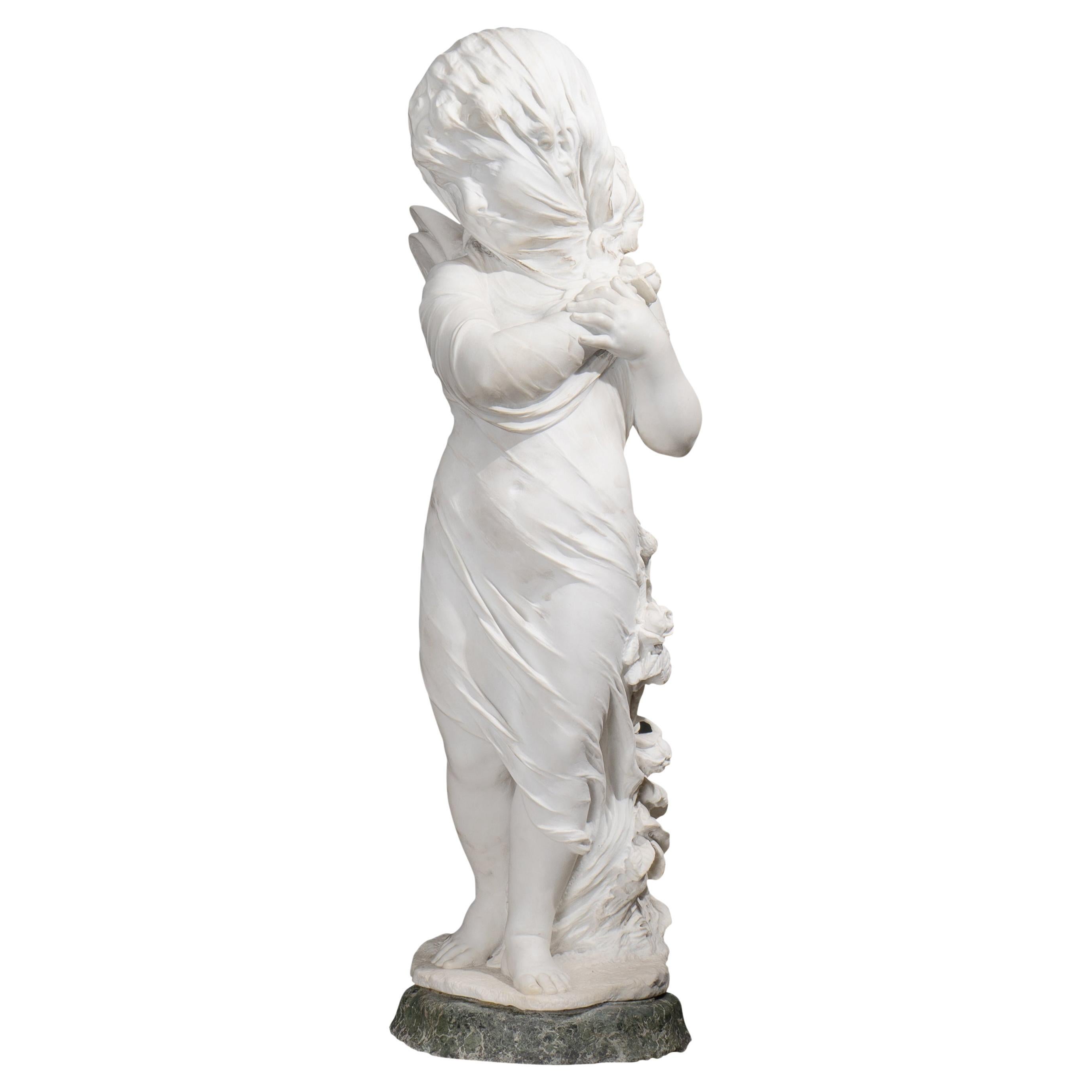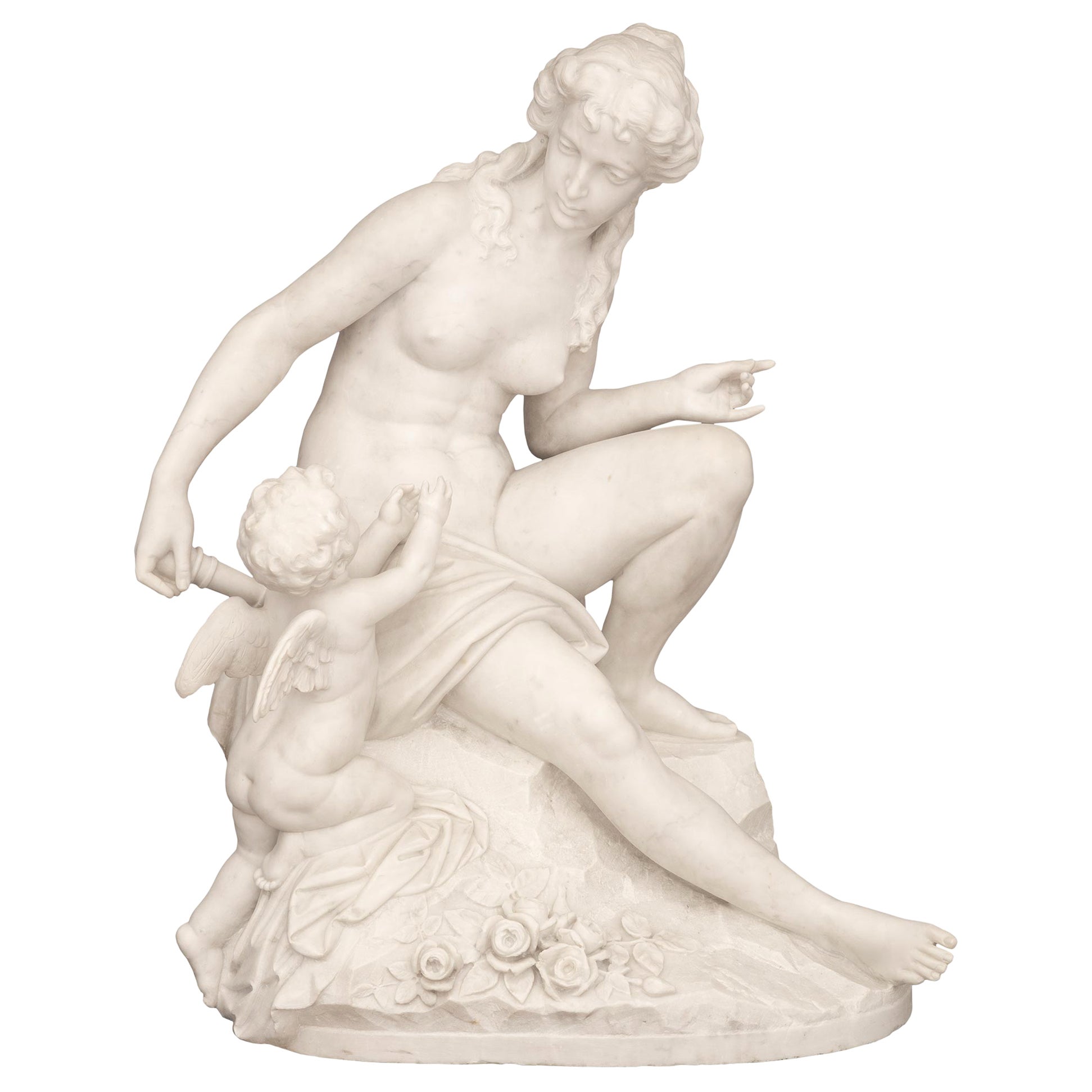Items Similar to 19th Century, Italian White Marble Sculpture by Pompeo Marchesi with Cupid, 1840
Want more images or videos?
Request additional images or videos from the seller
1 of 21
19th Century, Italian White Marble Sculpture by Pompeo Marchesi with Cupid, 1840
About the Item
19th century, Italian white marble sculpture by Pompeo Marchesi with cupid, Italy, 1840
This valuable sculpture, made in white marble in 1840, is a work signed by Pompeo Marchesi.
It represents a cupid who writes. The cupid is the mythological personification of the god Love, depicted in poetry and art with the appearance of a child, mostly naked and winged. In this work appears lying prone on a soft drapery from which comes out a redundant composition of flowers. The cupid turns or looks forward to if lifting on his left arm; with his right hand he is intent on writing on a parchment. The feet, slightly raised, recall the childish attitude and contribute to give movement to the figure.
The work is representative of the romantic artistic expression of the famous Italian sculptor Pompeo Marchesi. Pompeo, son of Gerolamo Marchesi and Caterina Tamburini, was born in Saltrio (near Varese) on 7 August 1783. After a first training at the Brera Academy in Milan, he perfected in Rome under the guidance of Antonio Canova. Returning to Milan in 1810, Marchesi started the long activity for the construction of the cathedral, marking the beginning of an extraordinarily intense career. He won numerous awards, participated in the annual exhibitions of Brera, was very active in the decoration of large works of Urban Furniture including the Arco del Sempione in Milan and the Cathedral of Como. With the Restoration, Marquesas acquired considerable credit and soon became one of the leading interpreters of the Habsburg court, establishing himself internationally.
Appointed “Imperial regio statuario di corte” in 1838, thanks to the offices of F. von Hartig, Governor of Lombardy, Marquises obtained directly from the Emperor Ferdinand I the commission of the monument for the Vienna Hofburg.
The retirement from the Brera Academy in 1852 coincided with the beginning of the descending parable of the artist, who Stendhal had defined in the Certosa di Parma (1839) the "fashionable sculptor" of Lombardy. Marchesi died in Milan on 7 February 1858.
- Dimensions:Height: 10.63 in (27 cm)Width: 16.54 in (42 cm)Depth: 6.7 in (17 cm)
- Style:Romantic (Of the Period)
- Materials and Techniques:
- Place of Origin:
- Period:
- Date of Manufacture:1840
- Condition:
- Seller Location:IT
- Reference Number:1stDibs: LU4405218783172

About the Seller
5.0
Platinum Seller
These expertly vetted sellers are 1stDibs' most experienced sellers and are rated highest by our customers.
Established in 1980
1stDibs seller since 2019
41 sales on 1stDibs
Typical response time: 1 hour
- ShippingRetrieving quote...Ships From: Italy
- Return PolicyA return for this item may be initiated within 7 days of delivery.
More From This SellerView All
- 19th Century, Pair of French Porcelain Sculptures Depicting Cupid and PsycheLocated in IT19th century, pair of French polychrome porcelain sculptures depicting cupid and psyche The delicious sculptures, made of hand-painted porcelain in polychrome, in Strasbourg in th...Category
Antique 19th Century French Baroque Porcelain
MaterialsPorcelain
- 19th Century, French Terracotta Bust and Marble Base with NoblemanLocated in ITTerracotta bust depicting nobleman, marble base, 19th century, France The refined bust depicts a nobleman dressed according to the fashion of the mid-eighteenth century in France. T...Category
Antique 19th Century French Louis XV Busts
MaterialsTerracotta
- 19th Century, French Terracotta Bust and Marble base with NoblewomanLocated in ITTerracotta bust depicting noblewoman, marble base, 19th century, France The refined bust, made of terracotta, depicts a noblewoman dressed according to the fashion of the mid-eighte...Category
Antique 19th Century French Louis XV Busts
MaterialsTerracotta
- 19th Century, French Marble and Gilt Bronze CenterpieceLocated in IT19th Century, French Marble and Gilt Bronze Centerpiece This particular centerpiece was made, in white marble and finely chiseled gilded bronze, in France between the end of the eigh...Category
Antique 19th Century French Louis XVI Figurative Sculptures
MaterialsMarble, Bronze
- 18th Century, Italian Bronze Sculpture with Venus Removing Her SandalLocated in IT18th Century, Italian Bronze Sculpture with Venus Removing Her Sandal This bronze sculpture represents Venus as she takes off her sandal. Made in the neoclassical era in Italy, it consists of the bronze sculpture of the Greek goddess Aphrodite, Venus for the Romans. The naked goddess, getting ready for the bath, makes the very human gesture of loosing a sandal. The left arm is raised, as if to compensate the position while maintaining the balance. Next to her, wrapped around a rocky spur, is a dolphin, an animal iconographically linked to the goddess because of his birth from the foam of the sea. The figure rests on a cylindrical and concave bronze base, with finely chiselled reserves. The bronze element is in turn resting on a africano marble cylinder with black of Belgium marble base. Venus is one of the major Roman goddesses primarily associated with eros and beauty. It is traditionally understood as the equivalent of the Greek goddess Aphrodite, goddess of beauty, physical and passionate love, among the major deities of Olympus. His birth is due to a dramatic event: Uranus, Heaven, is mutilated by his son Cronus, who punishes him for the wrongs inflicted on his mother. The torn limbs of Uranus fall into the sea and fertilize the foam of the waves of the island of Cyprus. From the waves emerges in all its splendor Aphrodite. Since the 4th century, Aphrodite begins to be represented with characters more human and less heroic. Praxiteles with the 'Aphrodite Cnidia,' for the first time in the history of sculpture, depicts her naked, as she prepares to take a ritual bath. From the Pressitele’s model descend the Capitoline Venus (Capitoline Museums of Rome) and the Venus de’ Medici (Uffizi Museum of Florence) accompanied by Eros on the back of a dolphin. This vein also includes a subject frequently attested in the Hellenistic and then Roman Ages, with examples in bronze, marble and terracotta: the Aphrodite who fastens the sandal. The luck that this type of representation had in the following centuries is demonstrated by the vast number of sculptures that represent it. In this bronze work the goddess resumes the position of Oplontis’s Naked Venus: here Venus holds an apple in her left hand, a reminder of her victory in the beauty contest in which she prevailed over Minerva and Juno by judgment of Paris. In our bronze instead, the hand seems to want to shake the apple, which however has not been molded. Perhaps the bronze is inspired by another work, such as the bronzes kept in the archaeological museum of Padua. Another example is the famous 'Venus in bikini" found in Pompeii, so-called because it depicts the goddess in the same pose, but with the breasts and hips covered by bands painted in gold. The dolphin depicted next to it could be inspired instead to the Medici Venus...Category
Antique Late 18th Century Italian Neoclassical Figurative Sculptures
MaterialsMarble, Belgian Black Marble, Bronze
- 20th Century, Italian Sculpture by Helen König Scavini, Lenci ManufactoryBy Lenci, Helen ScaviniLocated in ITHelen König Scavini, Lenci manufactory "Nude of Woman", e.g. 1927-1936 Signed under the base "Lenci/Italy" Glazed terracotta sizes: H 70 cm x W front 83 cm (W back 55 cm) x D 55 cm The important sculpture, realized in glazed terracotta, is by the famous Lenci Manufactory of Turin (Italy) on model by Helen König Scavini. Of remarkable dimensions, it represents a naked woman, covered of a single cloth to life, sitting with the legs flexed asymmetrically while it supports on the arms with the hands leaned to the plan. The woman has a hieratic expression, big eyebrow arches under which the ethereal eyes are half-closed; the open lips hide a hint of a smile. The loose hair is turned back with big waves on both the head and along the back. The staining of the glazing is on the tones of musky green, which contributes to confer to this woman the appearance of a nymph or a mythological figure. Below the base is found, hand painted, the trademark of the manufacture "Lenci, ITALY". The brand Lenci was registered in Turin on 23 April 1919, sanctioning an activity undertaken some time before by Helen König, wife of the commercial agent Enrico Scavini. The origin of the word Lenci is still controversial today; the earliest bibliography says it derived from a endearment of Elena (Elenchen, as her father called her and that she, stunned him, pronounced Lenci) while the most recent one considers the acrostic Ludus Est Nobis Costanter Industria, perhaps invented by Ugo Ojetti or built as divertissement by the poet Ignazio Vacchetti (Alias Fantasio) on the endearment of Elena. The Lenci manufactory becomes a meeting point for artists and a forge of ideas for the development and realization of dolls and puppets, children’s furniture, and later also artistic ceramics. The first artists to take an active part in the enterprise were Giovanni Riva and Sandro Vacchetti, soon joined by other great names. The success of these felt dolls earned numerous awards to the Lenci Company during the international exhibitions in Zurich, Paris, Rome or Milan. However, the originality of Lenci’s creations was soon put to the test by numerous imitations. To cope with this type of competition, Lenci began to produce artistic ceramics, whose activity began in 1927. The ceramic figures became perhaps even more famous than the dolls in cloth. The subjects ranged from the famous "nudini", the chic little ladies and emancipated women, from fantasy characters to animals, from religious images to the most disparate vases and much more. Many artists collaborated in the realization of the models, among which it is worth mentioning the already mentioned Sandro Vacchetti, artistic director of Lenci from 1922-1934, the same Elena König Scavini, Cläre Burchart, Lino berzoini, Giovanni Riva, Giovanni Ronzan, Deabate Theonesto, Giovanni Pietro Spertini, Marcello Dudovich, Gigi Chessa, Mario Pompei, Nillo Beltrami, Mario Sturani, Giulio Da Milano, Giovanni Grande, Ines Grande, Claudia Formica, Luigi Borione, Camillo Ghigo, Giuseppe Porcheddu, Gino Levi-Montalcini, Abele Jacopi...Category
Vintage 1930s Italian Figurative Sculptures
MaterialsTerracotta
You May Also Like
- 19th Century Italian Marble Sculpture of Cupid Veiled by Orazio AndreoniBy Orazio AndreoniLocated in Los Angeles, CAA sculpture by Orazio Andreoni from the late 19th to early 20th century portraying a veiled Cupid exudes an exquisite blend of classical artistry and romantic allure. Andreoni, known...Category
Antique Late 19th Century Italian Figurative Sculptures
MaterialsCarrara Marble
- 19th Century, Italian Carrara Marble Sculpture of Two Putti Cupid & EratoLocated in London, GBAllegories of the Greek Gods Eros & Erato An Italian Carved Sculptural Group Carved from a single block of Carrara marble, the winged putti cavorting together, one playing a trum...Category
Early 20th Century Italian Figurative Sculptures
MaterialsCarrara Marble
- Italian 19th Century White Carrara Marble Statue of Young CupidLocated in West Palm Beach, FLA most charming and finely detailed Italian 19th century white Carrara marble statue of young cupid. The statue is raised by a circular base with a fine wrap around mottled design. T...Category
Antique 19th Century Italian Figurative Sculptures
MaterialsCarrara Marble
- Italian 19th Century White Carrara Marble Statue of Sleeping CupidLocated in West Palm Beach, FLA charming Italian 19th century white Carrara marble statue of sleeping Cupid. The statue is raised by a terrain designed base where the richly sculpted Cupid sleeps. He lays on a wonderfully executed blanket with his head resting gently on a rock. He holds his bow and quiver...Category
Antique 19th Century Italian Figurative Sculptures
MaterialsCarrara Marble
- From the model of Pompeo Marchesi - Sculpture, Sitting Manly Portrait (Ariodante) -Located in Felino, ITSculptural reproduction in vitrified stone and reinforced plaster . Copy of "Seated Manly Portrait," by Vittorio Alfieri, made by Pompeo Marchesi (ca. 1840). Signature on the base "A...Category
Vintage 1940s European Directoire Figurative Sculptures
MaterialsStone
- Italian 19th Century White Carrara Marble Statue of a Venus and CupidLocated in West Palm Beach, FLA charming and large scaled Italian 19th century white Carrara marble statue of a Venus and Cupid. The young Venus is seated on a rock with a flowing garment draped over her leg whil...Category
Antique 19th Century Italian Figurative Sculptures
MaterialsMarble
Recently Viewed
View AllMore Ways To Browse
1840 Flowers
1840 Italian Furniture
Large Italian Marble Sculpture
Large White Marble Sculpture
Marble Flower Sculpture
Italian Draperies
Italian Drapery
Marble Feet Sculpture
Italian Monumential
Cupid Love
Drapery Sculpture
Child Sculpture Marble
Cupid Sculpture
Parma Italy
Large Wing Sculpture
Marble Sculpture God
Marble Cupid
Italian Hand Carved White Marble Sculpture





